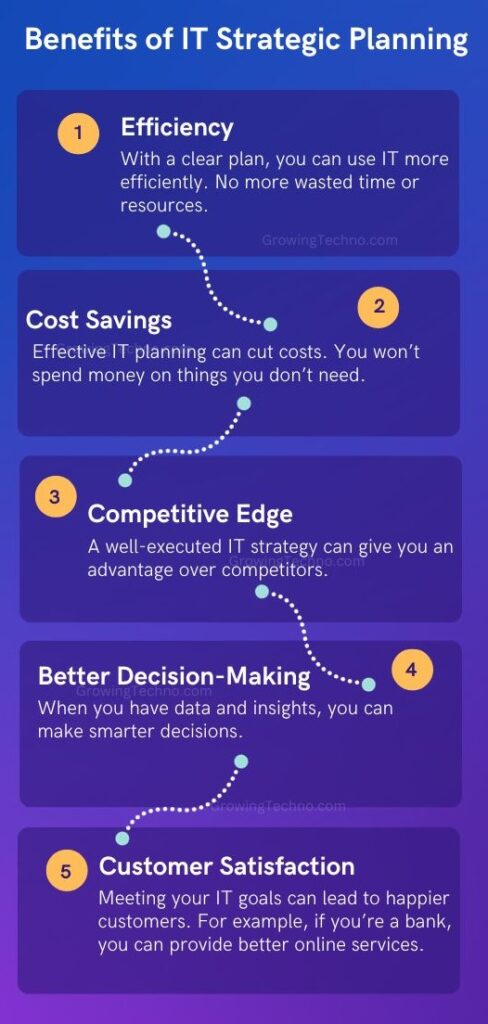
In today’s digital-driven world, information technology (IT) is the backbone of businesses and organizations. To make the most of IT, you need a solid strategy. But don’t worry; developing and implementing your IT strategy doesn’t have to be complicated. In this article, we’ll break it down into simple, actionable steps.
What is IT Strategic Planning?
Imagine your organization’s IT as a journey, and IT strategic planning is like creating a roadmap for that journey. It’s not reserved for large corporations; even small businesses and nonprofits can benefit from it. Essentially, it’s a structured approach to deciding how technology can help you reach your goals. It’s about setting clear objectives and understanding how IT can support those objectives.
Why Do You Need IT Strategic Planning?
Think of IT strategic planning as your playbook in a sports game. It’s your game plan for using technology to achieve your objectives. IT can be a powerful tool to enhance your organization’s efficiency, reduce costs, and expand your reach to new customers. With a well-thought-out IT strategy, you’ll be in a better position to leverage technology to your advantage.
Step 1: Understand Your Business
Before you even begin crafting an IT strategy, it’s crucial to have an in-depth understanding of your organization. This step involves getting to the core of what your organization does and what it aspires to achieve. For instance, if you’re running a hospital, your goals may revolve around providing top-notch patient care while simultaneously reducing operational costs. On the other hand, if you’re managing a retail store, you might aim to increase sales and enhance customer satisfaction.
Step 2: Identify IT Opportunities
Once you’ve grasped the intricacies of your organization, the next step is to identify where information technology can play a pivotal role. In the context of a hospital, this could involve recognizing the need for a new and efficient patient record system to enhance the quality of healthcare. For a retail store, it might entail recognizing the potential for an e-commerce website to tap into online sales opportunities.
Step 3: Set IT Goals
With a clear understanding of your organization’s objectives and the IT opportunities, it’s time to set specific and measurable IT goals. These goals serve as the targets you aim to reach. For instance, if you’re a retail store, your plan might be to boost online sales by 20%. If you’re in the healthcare sector, your goal could be to reduce patient wait times by 15%.
Step 4: Plan Your IT Projects
To achieve these IT goals, you need concrete actions. These actions are your IT projects. For example, if you’re a retail store, one of your projects could involve developing and launching an e-commerce website. In the context of a hospital, a project might involve implementing a new patient record system to improve the quality of care.
Step 5: Budget Your IT Projects
While having great project ideas is essential, it’s equally important to ensure that you have the financial resources to carry them out. Budgeting involves estimating the costs associated with each IT project. This step is crucial to ensure that you have the necessary funds to make your IT strategy a reality.
Step 6: Prioritize Projects
Chances are, you might have more IT projects in mind than you can undertake at once. That’s where prioritization comes in. It’s about determining which projects are the most critical and need to be implemented first. Prioritizing helps you focus your resources where they can have the most significant impact.
Step 7: Create an IT Roadmap
An IT roadmap is like a detailed schedule for your projects. It lays out when each project will begin and when it’s expected to be completed. This timeline keeps you on track and ensures that projects progress in an organized manner.
Step 8: Communicate Your IT Strategy
For your IT strategy to be successful, it’s essential that everyone in your organization understands it. Clear communication of the strategy is key. When your team comprehends the strategy, they can work together effectively to bring it to fruition.
Step 9: Implement Your Projects
With your plan in place, it’s time to implement it. Implementation involves executing your projects one by one, following the schedule set in your IT roadmap.
Step 10: Monitor and Adjust
As your IT strategy unfolds, it’s crucial to keep a close watch on your progress. Are you moving in the right direction to meet your IT goals? If you encounter roadblocks or find that your strategy isn’t yielding the expected results, be prepared to make adjustments. Flexibility is essential as it allows your strategy to evolve as circumstances change.
Benefits of IT Strategic Planning
Why go through all this effort? Here are some benefits:

Challenges of IT Strategic Planning
IT strategic planning isn’t always a walk in the park. Here are some challenges:
- Complexity: IT can be complex, and planning takes time.
- Resources: You need the right people and funds to make your plan work.
- Changing Technology: IT changes fast. Your plan needs to adapt.
- Resistance to Change: Some people might not like new IT processes. It’s essential to manage this resistance.
Real-World IT Strategic Planning
Let’s take a closer look at how IT strategic planning plays out in a real-world scenario, using a small online retail business called “Tech Haven” as an example.
Step 1: Understand Your Business
Tech Haven is an online retailer specializing in electronic gadgets. Their primary objective is to boost sales and enhance customer satisfaction. To achieve these goals, they recognize the need for a well-defined IT strategy.
Step 2: Identify IT Opportunities
Upon thorough analysis, Tech Haven identifies a common challenge: many customers abandon their shopping carts before completing a purchase. This signals a significant opportunity for improvement. They realize that by enhancing the online shopping experience, they can reduce cart abandonment and increase sales.
Step 3: Set IT Goals
With a clear understanding of their business and the identified IT opportunity, Tech Haven sets a specific IT goal. They aim to decrease cart abandonment by 15% over the next year. This goal serves as a target to work towards.
Step 4: Plan Your IT Projects
To achieve their goal, Tech Haven outlines a primary IT project. They decided to revamp their website to make it more user-friendly and visually appealing. This project directly addresses the issue of cart abandonment and aligns with their business objective of improving the online shopping experience.
Step 5: Budget Your IT Projects
Tech Haven estimates that they will require a budget of $20,000 to carry out the website revamp successfully. Accurate budgeting is crucial to ensure they have the financial resources needed for project implementation.
Step 6: Prioritize Projects
Recognizing the importance of the website revamp project in achieving its goal, Tech Haven prioritizes it as a top-tier project. This ensures that they allocate the necessary focus and resources to it.
Step 7: Create an IT Roadmap
An IT roadmap is essential for keeping the project on track. Tech Haven schedules the start of the website revamp for three months from the strategy’s initiation and plans to complete it within six months. This timeline provides a clear structure for project execution.
Step 8: Communicate Your IT Strategy
Open communication is vital. Tech Haven’s owner effectively conveys the IT strategy to the team. Every member understands the overarching goal and the specific project aimed at achieving it. This clarity ensures that the entire team is aligned in their efforts.
Step 9: Implement Your Projects
Tech Haven proceeds with the website revamp according to the established timeline. They follow the IT roadmap diligently to ensure that the project stays on schedule.
Step 10: Monitor and Adjust
As the website revamp unfolds, Tech Haven monitors key performance indicators, particularly the cart abandonment rate. If they notice that the rate is not improving as expected, they are prepared to make necessary adjustments to the project or the overall strategy. This adaptability is essential to ensure that the IT strategy remains effective and responsive to changing circumstances.
In the end, Tech Haven’s IT strategy has a tangible impact. By addressing the issue of cart abandonment through the website revamp, they successfully reduced abandonment rates, increased sales, and enhanced customer satisfaction. This real-world example illustrates how IT strategic planning, when executed effectively, can lead to substantial improvements and align an organization’s IT efforts with its business objectives. It showcases the practical application of the steps involved, from setting clear goals to project implementation and ongoing monitoring.
Conclusion
IT strategic planning is about making IT work for your business. It’s not just for big corporations; even small businesses can benefit. By understanding your business, identifying IT opportunities, and following these steps, you can develop and implement a successful IT strategy. It will lead to greater efficiency, cost savings, and a competitive edge. Challenges exist, but with the right approach, your IT strategy can lead your organization to success. So, go ahead and plan your IT strategy—it’s the roadmap to a brighter IT future.












